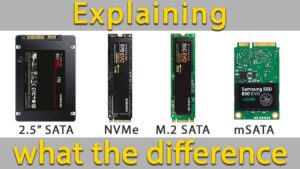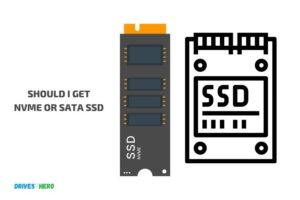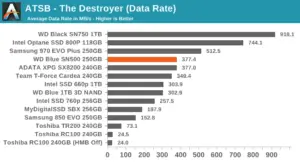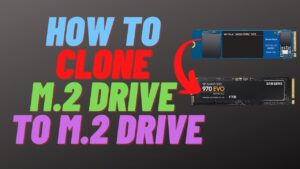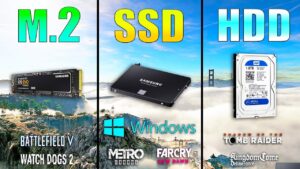How to Partition Nvme Ssd? 8 Steps!
Partitioning your NVMe SSD is a crucial step to optimize storage space and organize data effectively. By dividing the SSD into multiple partitions, you can segregate different types of data, improve system performance, and enhance data management.
This step-by-step guide will walk you through the process of partitioning your NVMe SSD using Disk Management in Windows, ensuring a smooth and hassle-free experience.

Key Takeaway
Step-by-Step Guide to Partitioning NVMe SSD
Step 1: Access Disk Management
- Press Win + X and choose “Disk Management” from the menu.
- Alternatively, type “disk management” in the Windows search bar and select the matching result.
Step 2: Locate NVMe SSD
- Identify your NVMe SSD from the list of drives displayed in Disk Management.
Step 3: Initialize SSD
- Right-click on the unallocated space of the NVMe SSD.
- Choose “Initialize Disk” and select either MBR or GPT partition style.
Step 4: Create Partition
- Right-click on the unallocated space of the SSD.
- Select “New Simple Volume” from the context menu.
Step 5: Partition Wizard
- Follow the wizard to specify partition size, assign a drive letter, and choose a file system (usually NTFS).
Step 6: Repeat for Additional Partitions (Optional)
- If needed, repeat Step 4 and Step 5 to create more partitions on the SSD.
Step 7: Format Partitions
- Right-click on each partition.
- Choose “Format” and follow the prompts to format the partition with the selected file system.
Step 8: Finalize
- Once all partitions are formatted, close Disk Management.
- Your NVMe SSD is now partitioned and ready for use.
By following these steps, you can easily partition your NVMe SSD to organize your data efficiently and effectively. Remember to backup important data before making any changes to disk partitions.
Five Facts About: How to Partition Nvme Ssd
Preparing For Partitioning
Partitioning your NVMe SSD can be done easily with these simple steps. Follow our guide to ensure a smooth and efficient process without any hassle.
Checking System Requirements:
Before starting the partitioning process, it’s essential to ensure that your system meets the necessary requirements.
Here’s a checklist to help you verify the compatibility of your system:
- Operating System: Check if your operating system supports NVMe SSD partitioning. Most modern operating systems like Windows 10, macOS High Sierra (10.13) and above, and Linux kernel 3.3 and later have built-in NVMe support.
- System Architecture: Confirm if your system has an NVMe-compatible motherboard. NVMe SSDs require a PCIe (Peripheral Component Interconnect Express) slot with NVMe support.
- Available Slots: Determine the number of available PCIe slots in your system to accommodate the NVMe SSD. Additionally, check if any other devices are occupying the other slots to avoid conflicts.
- Power Supply: Ensure that your power supply unit (PSU) can provide sufficient power to the NVMe SSD, as these drives may have higher power requirements compared to traditional SATA drives.
Backing Up Important Data:
Before embarking on the partitioning process, it is crucial to safeguard your important data. Taking a backup ensures that you don’t lose any valuable files during the partitioning process.
Here are some backup options you can consider:
- External Hard Drive: Connect an external hard drive or SSD to your system and transfer all necessary files onto it. This will serve as a secure storage for your data during the partitioning process.
- Cloud Storage: Upload your important files to a cloud storage service such as Google Drive, Dropbox, or OneDrive. This way, your files will be accessible from any device and remain safe even if something goes wrong during the partitioning process.
- Network Attached Storage (NAS): If you have a NAS device, use it to create a backup of your data. NAS devices offer data redundancy and can be accessed by multiple devices on your network.
Gathering Necessary Tools And Software:
To ensure a smooth partitioning process, it is essential to gather the necessary tools and software before you start.
Here are the key items you will need:
- NVMe Partitioning Software: Download a reliable NVMe partitioning software that is compatible with your operating system. Some popular options include EaseUS Partition Master, MiniTool Partition Wizard, and AOMEI Partition Assistant.
- Screwdriver: Have a screwdriver handy to open your system’s case and install the NVMe SSD securely.
- Antistatic Wrist Strap: To prevent any static discharge that could damage your NVMe SSD, use an antistatic wrist strap while working on your system.
Once you’ve completed these preparations, you’ll be ready to move on to the next steps in the partitioning process.
Different Methods Of Partitioning Nvme Ssds
Looking to partition your NVMe SSD? There are various methods you can use to easily partition your SSD without any hassle. Optimize your storage space and improve performance with these effective techniques.
When it comes to partitioning NVMe SSDs, there are a few different methods you can use, depending on your operating system and preferences.
Using Disk Management In Windows:
- Open Disk Management by right-clicking on the Start menu and selecting “Disk Management”.
- Locate your NVMe SSD in the list of drives and right-click on it.
- Choose the option “Shrink Volume” to create unallocated space on your NVMe SSD.
- Right-click on the unallocated space and select “New Simple Volume” to create a new partition.
- Follow the prompts to specify the partition size, assign a drive letter, and format the partition.
Using Disk Utility In Macos:
- Open Disk Utility by navigating to “Applications” > “Utilities” > “Disk Utility”.
- Select your NVMe SSD from the list of drives on the left-hand side.
- Click on the “Partition” tab in the main window.
- Click the “+” button to create a new partition.
- Adjust the size and name of the partition as desired.
- Choose the file system format for the partition, such as APFS or Mac OS Extended (Journaled).
- Click “Apply” to save the changes and create the partition.
Using Third-Party Partitioning Software:
- Download and install a reliable third-party partitioning software of your choice.
- Launch the software and select your NVMe SSD from the list of drives.
- Choose the option to create a new partition or resize an existing one.
- Specify the desired size and name for the partition.
- Select the file system format for the partition.
- Apply the changes and let the software handle the partitioning process.
There are multiple ways to partition NVMe SSDs. If you’re a Windows user, Disk Management provides a straightforward interface, while macOS users can rely on Disk Utility.
Those who prefer more advanced partitioning options can explore third-party software solutions. Choose the method that suits your needs and take advantage of the benefits of properly partitioning your NVMe SSD.
Advanced Partitioning Techniques For Nvme Ssds
Discover advanced techniques to effectively partition NVMe SSDs for optimal performance and efficiency. Maximize your storage capacity and enhance your system’s functionality with these expert strategies.
Partitioning NVMe SSDs is an essential step in optimizing their performance and maximizing their storage capacity.
Raid Configurations With Nvme Ssds:
- RAID 0: Combines multiple NVMe SSDs into a single logical unit, offering increased performance and capacity. However, it does not provide data redundancy, so a failure in one drive can result in complete data loss.
- RAID 1: Mirrors the data across multiple NVMe SSDs, providing data redundancy and increased reliability. Although it doesn’t offer improved performance or capacity, it ensures high data availability.
- RAID 5: Distributes the data across multiple NVMe SSDs, along with parity information. This configuration offers good performance, capacity, and data redundancy, allowing for the recovery of data in case of a drive failure.
Merging And Splitting Partitions:
Merging partitions:
- Identify partitions that you want to merge based on their proximity or purpose.
- Back up any important data from the partitions you plan to merge.
- Use a reliable partition management tool to merge the selected partitions into a single partition.
- Ensure that the merged partition’s file system is intact and accessible.
Splitting partitions:
- Determine the size and allocation requirements for the new partitions.
- Back up any crucial data from the partition you intend to split.
- Use a trusted partition management tool to split the selected partition into multiple partitions based on your requirements.
- Verify the file system integrity of the newly created partitions to ensure successful functionality.
Aligning Partitions For Optimal Performance:
When partitioning NVMe SSDs, aligning the partitions improves performance by optimizing the data flow.
Here’s how you can align partitions for optimal performance:
- Start each partition at the appropriate alignment boundary, typically 1MB or 4KB, depending on your OS and file system.
- Use specialized partitioning software that ensures the partitions are aligned correctly.
- Aligning partitions reduces read/write latency and improves overall SSD performance.
By implementing advanced partitioning techniques, such as RAID configurations, merging, splitting, and aligning partitions, you can effectively manage and enhance the performance of your NVMe SSDs.
Remember to always back up your data and use reliable partition management tools to ensure a smooth partitioning process.
Tips For Optimizing Partitioned Nvme Ssds
Discover effective tips for optimizing your partitioned NVMe SSDs. Learn how to partition your NVMe SSD to maximize performance and efficiency. Enhance your storage capabilities with these tried-and-tested techniques.
Partitioning an NVMe SSD can offer several benefits, including improved performance and better organization of your data.
Enabling Trim For Improved Performance
TRIM is an essential feature for SSDs that helps maintain their performance over time.
By enabling TRIM for your partitioned NVMe SSDs, you can ensure that unused blocks of data are quickly flagged for deletion, allowing your SSD to operate more efficiently.
To enable TRIM:
- Open Command Prompt (Windows) or Terminal (Mac/Linux).
- Type the command: ‘fsutil behavior set DisableDeleteNotify 0’ and press Enter.
- Restart your computer for the changes to take effect.
Managing Unused Disk Space
It is important to manage unused disk space on your partitioned NVMe SSD to prevent performance degradation. When your SSD is nearly full, write operations can become slower, affecting overall responsiveness.
Consider these strategies for managing unused disk space:
- Regularly delete unnecessary files and folders to free up disk space.
- Utilize storage optimization tools provided by your operating system to identify large files and unused applications.
- Consider moving non-essential data to secondary storage devices to free up space on your NVMe SSD.
Keeping Partitions Well-Organized
Follow these practices to keep your partitions well-organized:
- Plan your partition layout ahead of time, considering factors such as operating system requirements, data storage needs, and future scalability.
- Label partitions with descriptive names to easily identify their content.
- Avoid creating too many small partitions, as this can lead to fragmentation and reduced performance.
- Regularly review and adjust partition sizes as your storage needs evolve.
By implementing these tips, you can optimize the performance and usability of your partitioned NVMe SSDs. Take advantage of TRIM, manage unused disk space effectively, and keep your partitions well-organized to ensure a smooth and efficient storage experience.
Troubleshooting Common Partitioning Issues
If you’re encountering issues with partitioning your NVMe SSD, troubleshooting common problems can help. Follow these steps to successfully partition your SSD and optimize its performance.
Partitioning your NVMe SSD is an essential step in optimizing its performance and managing your disk space effectively.
However, you may encounter some common issues during the partitioning process. In this section, we will discuss three common problems and provide solutions to address them.
Partition Not Showing Up:
- Check if the NVMe SSD is properly connected to your system.
- Ensure that the NVMe SSD is recognized by your operating system.
- Verify that the NVMe SSD is supported by your system’s BIOS.
- Use disk management tools to rescan for new partitions.
Unable To Create Or Delete Partitions:
- Make sure you have the necessary administrative privileges to create or delete partitions.
- Confirm that there is sufficient unallocated space available on the NVMe SSD.
- Check if the NVMe SSD is write-protected, as it may prevent partition creation or deletion.
- Utilize disk management tools or third-party partitioning software to perform the desired actions.
Disk Space Allocation Problems:
- Review the existing partitions on the NVMe SSD and consider resizing or merging them if necessary.
- Some operating systems require specific partitioning schemes (e.g., MBR or GPT). Ensure your NVMe SSD adheres to the correct scheme.
- Check for any corrupt or damaged partitions that might be causing allocation issues and repair them using disk management tools.
- If you encounter issues with unevenly allocated or inaccessible disk space, consider reformatting the NVMe SSD and starting the partitioning process again.
By troubleshooting these common partitioning issues step by step, you can ensure a smooth and successful partitioning experience for your NVMe SSD, optimizing its performance and organization.
FAQ About How to Partition Nvme Ssd
What is an NVMe SSD?
NVMe SSD stands for Non-Volatile Memory Express Solid State Drive. It is a high-performance storage device designed for use in enterprise and consumer applications.
It is faster than traditional hard disk drives and provides better durability and reliability.
How do I partition an NVMe SSD?
To partition an NVMe SSD, you will need to use a disk management utility such as Diskpart. This utility can be used to create and delete partitions on the NVMe SSD as well as to format and assign drive letter to partitions.
Are there any special considerations when partitioning an NVMe SSD?
Yes, some considerations should be taken into account when partitioning an NVMe SSD.
It is important to ensure that the partition size is properly aligned with the SSD so that the device can operate at optimal performance.
It is important to follow the manufacturer’s instructions when partitioning the NVMe SSD.
What are the benefits of partitioning an NVMe SSD?
Partitioning an NVMe SSD can provide several benefits. It can reduce the amount of data stored on the drive
Conclusion
Partitioning your NVMe SSD can greatly improve its performance and optimize its space allocation. By dividing your drive into multiple partitions, you can better organize your data, separate your operating system from your files, and even create a separate partition for virtual memory.
This not only enhances efficiency but also protects your data from accidental deletion or corruption. To partition your NVMe SSD, start by backing up your important data to ensure its safety during the partitioning process.
Then, use a reliable partitioning tool or your computer’s built-in disk management utility to create the desired partitions.
Remember to allocate appropriate sizes to each partition based on your needs. Once your SSD is partitioned, you can enjoy a more organized and efficient storage system.

